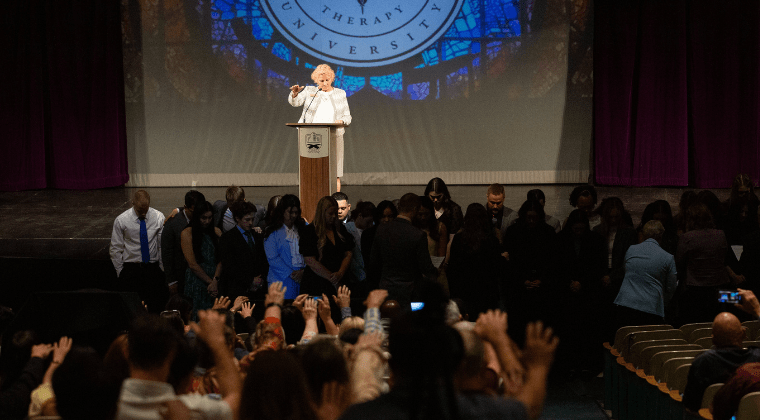Research that Impacts: Enhancing Training in Athletes Through New Methods
Part Two: The Doctor of Physical Therapy 29th Annual Scientific Inquiry Event

At Hardin-Simmons University, the Doctor of Physical Therapy (DPT) program is a dynamic, hands-on degree program that extends beyond textbooks and lectures, shaping the future of healthcare. Students aren’t just learning; they’re discovering, innovating, and shaping the field of physical therapy with research that has real-world impact.
Each year, the graduating class presents a year of dedicated research at the Annual Scientific Inquiries in Physical Therapy Practice event. This milestone marks the culmination of their academic journey before embarking on clinical rotations. Guided by expert faculty, students are assigned to a team to conduct in-depth research and present their findings, demonstrating their readiness to advance the field of physical therapy.
Step into the lab, onto the field, and into the minds of these trailblazing students as they explore groundbreaking concepts and push the boundaries of patient care.
Safety Squat Bar for Female Softball Players – Elizabeth (Lizzy) Avilla ’25 | El Paso, Texas
Elizabeth Avilla, a student from El Paso, Texas, and her team investigated the safety squat bar for female softball players. Driven by their desire to collaborate with an outside team and test a hypothesis with real-world application, their research aimed to address a common issue in sports: lower back injuries among athletes, particularly those who start lifting weights at a young age.
“One of the main challenges athletes face is improper lifting, especially when coaches don’t have a sports-specific background to guide them properly,” Lizzy explains. “This is a widespread issue, and it leads to a higher risk of injury, particularly in the lower back.”
The team’s research found that the safety squat bar offers a promising solution. Unlike traditional squat bars, the safety squat bar directs the load of the bar forward on the body, which reduces stress on the lower back.
“The front-loaded feeling helps athletes maintain a proper center of pressure, preventing the back from extending too far and increasing the risk of injury,” Lizzy notes. “A more posterior load will cause the individual to extend the back, which increases pressure on the lower back, which can cause an improper lift.”
Lizzy shared that during testing, athletes found the safety squat bar’s forward load unfamiliar, as they were accustomed to using a traditional barbell. However, as the athletes adapted to the new sensation, they began to see the benefits, including better control and reduced discomfort.
The team believes this research could have a lasting impact on strength training programs for softball players, where explosive leg movements are critical.
“We see the potential for the safety squat bar to be adopted across all aspects of training, not just for strength, but also for power,” Lizzy says.
The benefits aren’t limited to softball players—this method can be beneficial for athletes across various sports and even for the general population.
Looking forward, Lizzy’s team plans to submit their findings to the Physical Therapy Board of Sport Science, with the goal of sharing their research with professionals in the field.
“We want physical therapists, athletic trainers, and community members to use this information to improve training practices and prevent injuries,” said Lizzy.
Isometric Potentiating Warm-Up for Baseball Pitchers – Leroy (Lee) Miller ’25 | Katy, Texas
Lee Miller, a student from Katy, Texas, and his team were drawn to the topic of isometric potentiating warm-ups due to their research advisor’s interest in baseball, as well as their own passion for the sport. Their study examined the effect of holding static contractions at high intensities before exercise on muscle activation and strength, providing an alternative approach to traditional warm-ups that focus on dynamic movements to increase blood flow.
“An isometric potentiating warm-up involves holding static contractions at high intensities, which helps improve neuromuscular efficiency and force production without causing fatigue,” Lee explains.
The results of their research were promising. For collegiate pitchers, the isometric potentiating warm-up increased throwing velocity, particularly within the first 4-6 minutes after the warm-up.
“The greatest increase in velocity occurred in the short window right after the warm-up,” Lee shared. “The coaches and players were surprised to see an increase in velocity.”
This finding could be a game-changer for pitchers looking to enhance their performance.
While their study did not focus on injury prevention, Lee believes the technique could also potentially have that benefit.
“Although we didn’t specifically examine injury prevention, it’s definitely an area for future research,” he says.
Both research projects offer promising opportunities for enhancing athletic performance and safety. They are just a small example of the research being conducted at Hardin-Simmons University, which helps shape the future of Physical Therapy.


